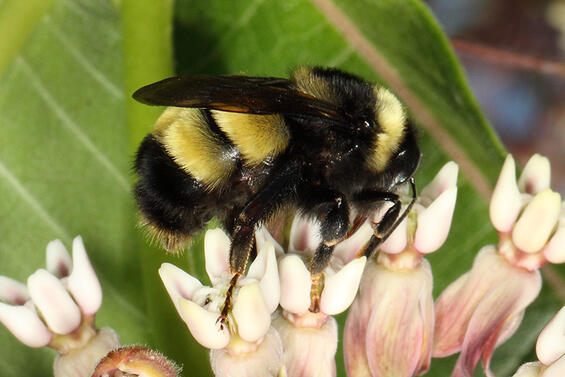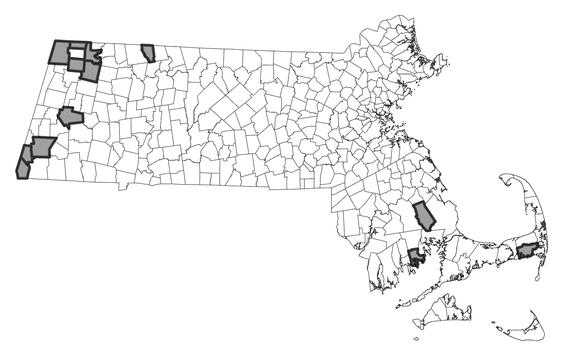- Scientific name: Bombus terricola
- Species of Greatest Conservation Need (MA State Wildlife Action Plan)
- Threatened (MA Endangered Species Act)
Description

Yellow-banded bumble bee (Bombus terricola)
The yellow-banded bumble bee (Bombus terricola) is of medium size, the queen 19-21 mm (0.7-0.8 in) long, worker 10-15 mm (0.4-0.6 in), and male 13-15 mm (0.5-0.6) (Williams et al. 2014). Color pattern is as follows: the face and upper side of the head are black, occasionally gray; the front of the thorax (just behind the head) is always yellow, contrasting with both the head and middle of the thorax, which are black (rarely gray); the rear of the thorax often has some yellow, but is usually mostly black or gray. The front of the abdomen is black, and the middle a wide yellow “band,” contrasting with the black front and the black rear. The rear of the abdomen usually has a small amount of yellow or orange at the tip. The yellow-banded bumble bee may be confused with the American bumble bee (Bombus pensylvanicus), although the latter is very rare in Massachusetts. Upon close examination, the yellow-banded bumble bee has a head that is wider than long (opposite in the American bumble bee); longer antennae than the American; and typically has yellow at the tip of the abdomen, unlike the queen and worker of the American (Williams et al. 2014).
Life cycle and behavior
Like all bumble bees, the yellow-banded bumble bee is active throughout the growing season. The queen overwinters and emerges in the spring to start a new colony. Workers become increasingly abundant through late summer and then begin to decline as males emerge in late summer and early fall.
Distribution and abundance
The yellow-banded bumble bee is a northern species, in eastern North America ranging from Newfoundland south to Pennsylvania, and further south at elevation in the Appalachian Mountains; it ranges “west through North Dakota and the Canadian Great Plains, to the tundra/taiga of Canada and the Mountain West, especially in British Columbia” (Williams et al. 2014). In Massachusetts, the yellow-banded bumble bee occurs primarily in Berkshire, Franklin, and northern Worcester Counties; it is very rare in other parts of the state.

Distribution in Massachusetts.
1999-2024
Based on records in the Natural Heritage Database.
Habitat
As a group, bumble bees are generalized in habitat requirements and floral resource needs as compared to many other bees. The yellow-banded bumble bee is a short-tongued species that can nevertheless “rob” nectar from plants with long, tubular flowers by chewing holes at the base of the flowers. The yellow-banded bumble bee is usually found in open areas with flowering plants within or adjacent to woodlands and wetlands, including suburban yards, parks, and gardens. However, habitat must provide a diversity of flowers blooming throughout the growing season. Within such habitat, this species nests underground in preexisting holes and crevices (for example, deserted rodent burrows), often under rocks or fallen trees or branches.
Healthy habitats are vital for supporting native wildlife and plants. Explore habitats and learn about conservation and restoration in Massachusetts.
Threats
The yellow-banded bumble bee has declined in parts of its range, including the northeastern U.S. (Grixti et al. 2009, Williams et al. 2009, Cameron et al. 2011, Williams et al. 2014, Colla 2016). In Massachusetts prior to 50 years ago, the yellow-banded bumble bee occurred throughout the state including the offshore islands. It has since declined dramatically, now largely restricted to Berkshire, Franklin, and northern Worcester Counties. Threats potentially affecting the yellow-banded bumble bee in Massachusetts include: (1) pathogens introduced via commercially propagated bumble bees; (2) habitat loss or degradation, including loss of native floral diversity to adverse landscaping practice, agricultural intensification, succession and afforestation, or excessive deer browse; (3) pesticide use where habitat overlaps or interfaces with agricultural or landscaped areas; and (4) climate change.
Conservation
Land protection and habitat management are the primary conservation needs of the yellow-banded bumble bee in Massachusetts. In particular, woodlands and wetlands with open areas with a diversity of flowering plants should be conserved, restored, and managed to maintain habitat for this species and other species dependent on such habitats.
Survey and monitoring
The distribution of the yellow-banded bumble bee in Massachusetts is relatively well-documented. As the decline of this species in Massachusetts may be ongoing, appropriate habitat should continue to be surveyed to better document this trend. Known populations should be surveyed to document persistence at least once every 25 years; every 10 years is more desirable when practicable.
Management
Management of open areas with flowering plants within or adjacent to woodlands and wetlands benefits a diversity of species. For the yellow-banded bumble bee, open areas with a diversity of flowers blooming throughout the growing season are of particular importance. Fallen woody debris should be left in place to increase the availability of suitable nesting sites. Threats such as introduced pathogens or pesticide use must be absent or sufficiently diffuse. Habitat condition should be monitored and management adapted as needed.
Research needs
The basic natural history and conservation needs of the yellow-banded bumble bee are relatively well known. However, the relative importance of various threats driving the current decline of his species in Massachusetts is not well understood. As with other northern species, the decline may be a result of climate change; this and other threats should be studied.
Acknowledgements
Significant contributions to our knowledge of the yellow-banded bumble bee in Massachusetts have been made by Robert Gegear, Joan Milam, and Michael Veit.
References
Cameron, S.A., J.D. Lozier, J.P. Strange, J.B. Koch, N. Cordes, L.F. Solter, and T.L. Griswold. 2011. Patterns of widespread decline in North American bumble bees. Proceedings of the National Academy of Sciences 108(2): 662-667.
Colla, S.R. 2016. Status, threats and conservation recommendations for wild bumble bees (Bombus spp.) in Ontario, Canada: a review for policymakers and practitioners. Natural Areas Journal 36(4): 412-426.
Grixti, J.C., L.T. Wong, S.A. Cameron, and C. Favret. 2009. Decline of bumble bees (Bombus) in the North American Midwest. Biological Conservation 142(1): 75-84.
Williams, P., S. Colla, and Z. Xie. 2009. Bumblebee vulnerability: common correlates of winners and losers across three continents. Conservation Biology 23(4): 931-940.
Williams, P., R. Thorp, L. Richardson, and S. Colla. 2014. Bumble Bees of North America. Princeton University Press, Princeton, New Jersey. 208 pp.
Contact
| Date published: | April 7, 2025 |
|---|